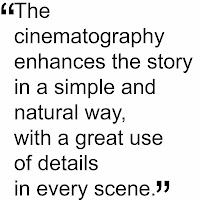La vie d'Adèle (also known as Blue is the Warmest Colour) is a film directed by Abdellatif Kechiche (Venus Noire, The Secret of the Grain, La Faute à Voltaire) that won The Palm d'Or at this year Cannes Film Festival.
The plot. Adèle is a young girl whose life and sexuality change when she meets Emma. Love and happiness will rise making Adèle grow into a woman, but when their relationship falls apart she has to find back herself.
Camera: Canon Eos C300
Lenses: Angenieux Optimo 28-76mm T2.6
Aspect ratio: 2.35:1
Format: MPEG-2
Film Stock: -
After working in his previous works, Sofian El Fani (The secret of the Grain, Le Fil, Paris la Métisse) repeats as Kechiche's cinematographer for La Vie d'Adèle. The film, rather than being a story between two homosexuals like everyone expects, is a look at what happen when you fall in love, independently of you gender or sexual orientation. In this sense, La Vie d'Adèle is a kind of documentary about Adèle's emotions, from love and happiness to fear and suffer. The cinematography reflects and enhances this point perfectly.
The choice of the Eos C300 along with just one lens used (a zoom lens but still one lens) is justified for the way of shooting: camera is hand held and follows the characters almost as in a documentary. So the Canon camera and the Angenieux Zoom offered lightness and practicability for this purpose. Actually, the C-log of the Eos worked really well, given the pleasant image offered, not hard at all as digital cinema normally is.
The Angenieux Lens is generally used at its longest focal length and at a quite wide aperture: the depth of field is very shallow, the characters are isolated from the background and are often out of focus when they move, giving the focus puller a hard job (which he did great, by the way).
There's a clear preference for close up shots: the reason is not only getting the audience closer to the characters; the main reason is that the film is about emotions and emotions are better expressed by face, and the great work of the two actresses made it easy to fill the frame with their face and looks.
Light has a natural feeling, of course, according to the story and way of filming. Windows, doors and on set lights are used as light sources, reinforced and softened. There's a preference, especially in the first half of the film, for back lighting: the key light is placed behind the character who never falls into silhouette anyway because the exposure is balanced with frontal fill lights.
 La Vie d'Adèle is translated in English as Blue is the Warmest Colour for a reason: the use of this colour throughout the film, an use which is, in a cinematographic point of view, very interesting. Normally blue is associated with coldness and distance not with warmth, while the colour representing love is red. The director and the cinematographer changed this relationship because they wanted to go further: in fact, blue is also the colour of freedom and the future. It is freedom what Adèle looks for when she first sees Emma, freedom for expressing her true feelings. This is what Emma's hair colour represents. She is the future for Adèle. That is why, in the gay bar, the first thing we see of Emma is the blue hair popping out from the darkness, that is why the first time Adèle and Emma makes love the linen of the bed are blue.
La Vie d'Adèle is translated in English as Blue is the Warmest Colour for a reason: the use of this colour throughout the film, an use which is, in a cinematographic point of view, very interesting. Normally blue is associated with coldness and distance not with warmth, while the colour representing love is red. The director and the cinematographer changed this relationship because they wanted to go further: in fact, blue is also the colour of freedom and the future. It is freedom what Adèle looks for when she first sees Emma, freedom for expressing her true feelings. This is what Emma's hair colour represents. She is the future for Adèle. That is why, in the gay bar, the first thing we see of Emma is the blue hair popping out from the darkness, that is why the first time Adèle and Emma makes love the linen of the bed are blue.
And it is also interesting to see how blue starts to fade along with the falling apart of their relationship: as soon as problems and doubts arise, Emma has blonde hair for example, or the colour of the sea where Adèle is swimming has a washed blue colour. This happens for small but important details too: at the beginning of the film we can see a picture of New york taken in the blue hour, which means that it has a blue cast; at the Adèle and Emma's rendez-vous, towards the end of the film, we can see some pictures of New York in the bar where they meet: they are in black and white.
Also in one of the final scene Adèle wears a blue dress (loaded with symbolism) when attending Emma's exhibition, perhaps in her last attempt to reconquer her; when she leaves her blue dress will be the only coloured object in a grey and desaturated surrounding.
La Vie d'Adèle is a marvellous film in which Kechiche managed to portrait like no one before what we go trough when we love someone; its cinematography is simple but powerful, enhancing the story through tiny important details.
hello, i'm studying this film, and i need to ask how do you get this information about camera e lens. do you have materials of this film like making of, interview with cinematography. thanks
ReplyDelete